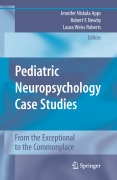
Pediatric neuropsychology case studies: from the exceptional to the commonplace
Apps, Jennifer Niskala
Newby, Robert F.
Roberts, Laura Weiss
In the recent literature, the most influential case study books in neuropsychology are in the adult realm. Pediatric neuropsychology is a rapidly developing field with increasingly greater influence in the assessment, diagnosis, early identification, and treatment of childhood illnesses. This book will providethe first centralized, comprehensive resource for case studies in pediatric neuropsychology. Not only will this supply a valuable compilation for the growing numbers of professionals in this field, but will also serve as an innovative and appealing resource for therapists, teachers, and others interested in child development. This book will be structured in such a way that readers can easily access individual cases of interest, as well as related areas of dysfunction. Section breakdowns will be provided in order to highlight the combined focus of case presentations in acquired neuropsychological dysfunction as well as developmental disorders. Each section will begin with an introductory chapter, highlighting the salient feature of the concept and providing brief, up todate reviews of the current research and theories. Within each global section, individual case studies will serve as stand-alone chapters. Contributing authors will be provided extensive guidance and coaching with regards to the standard format and information to be included in each chapter. The first section of this book will present cases involving neurological disorders. The intention of this section is to provide not only “classic” examples of neurological dysfunction in children, but also to provide interesting cases of unique or remarkable presentations. The second section will present an accumulation of casesrepresenting both common and progressive conceptualizations of developmental disabilities. Section three has been designed to highlight cases which often present complex issues to neuropsychologists. The case examples in this sectionwill highlight the use of alternative treatments, pathologies that are often a source of inquiry, and situations that lack the more rigorous scientific data often utilized in other diagnostic procedures. Additionally, this section may include chapters on common differential diagnosis dilemmas in clinical practice. Often multifaceted and even contradictory evidence can arise during evaluations, resulting in complex or problematic situations for the clinician. Suchexamples are difficult, by their nature, to forecast, but rather would be added during the book’s development, as they occur. First book to utilize a case study approach in neuropsychology where the focus is entirely pediatric but not limited to one etiology. Several chapters provide clinical case exemplifyinginnovative areas of diagnosis and treatment. Colorful, intriguing chapter titles ranging from the exceptional to the ordinary INDICE: Introduction.- Part I: “Dangers of Childhood” Neurological Disorders. Introduction “Dangers of Childhood”. Traumatic brain injury in the preschool years. Traumatic brain injury in the school-aged years. Traumatic brain injury in adolescence. Frontal lobe injury. Left hemisphere injury. Right hemisphere injury. Traumatic brain injury interacting with psychosocial factors and family stress. Physical trauma with associated brain injury “Dog Attack”. Rare systemic infections “How?” Encephalitic infection “Infected”.- Part II: “How It Can All Go Wrong” Developmental Disabilities. Section Introduction “How It Can All Go Wrong?” ADHD “Jeffrey”. ADHD as executive dysfunction “Mr. Disorganized”. ADHD Inattentive Type “Hello? Anyone Home?” Reading Disorder “Just Try Harder”. Phonological awareness deficits “Say What?” Rapid naming deficits “See…spot…run…”. Mathematics Disorder. Nonverbal Learning Disability. Pervasive Developmental Disorders. Bipolar Disorder “On Eggshells” Major Depressive Disorder. Disruptive Behavior Disorder. Genetic syndromes.- Part III: “He Said, She Said” Alternative Therapies and Popular Pathologies. Section Introduction “He Said, She Said”. Sensory Problems “Just Doesn’t ‘Feel’ Right”. Auditory Processing Disorder “He Won’t Listen”. Neuropsychology and Psychodynamic/Systems Psychotherapy. Low-to-medium Lead Exposure. Fetal Alcohol Effects. Post-Concussion Syndrome “Last Tackle of the Game”. Malingering “Can’t Think Straight”.- Neuropsychology in treatment planning.
- ISBN: 978-1-4419-6080-1
- Editorial: Springer
- Encuadernacion: Rústica
- Páginas: 364
- Fecha Publicación: 01/07/2010
- Nº Volúmenes: 1
- Idioma: Inglés
